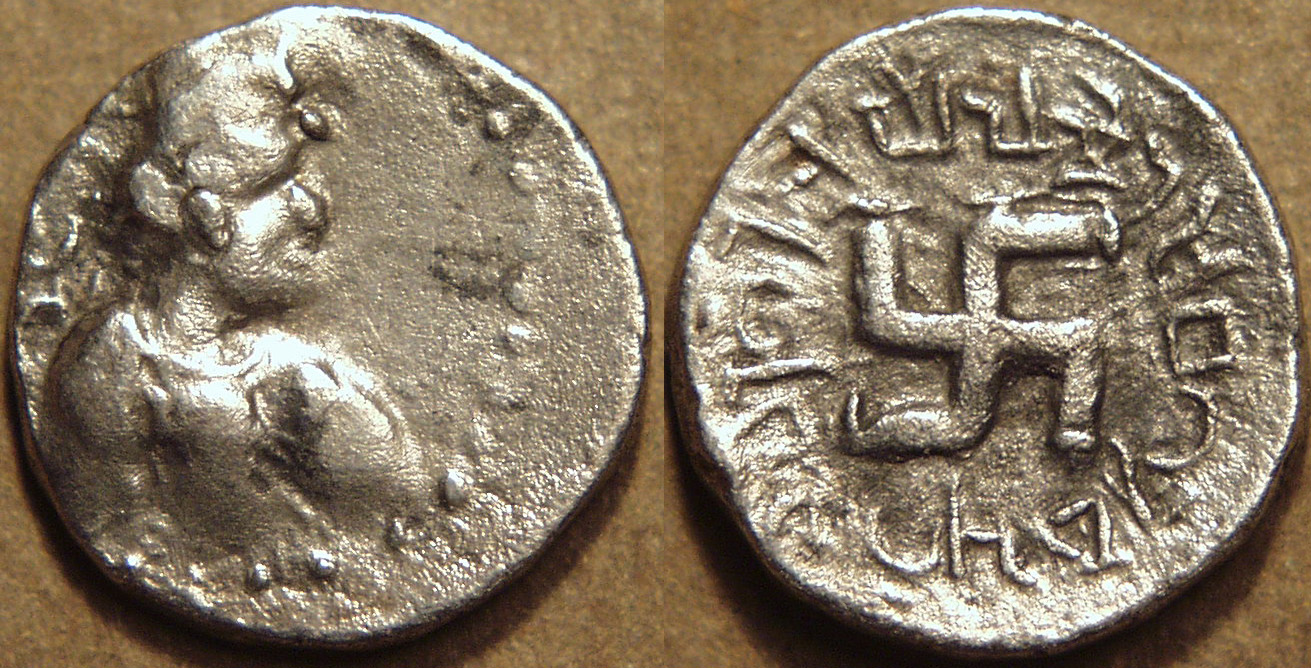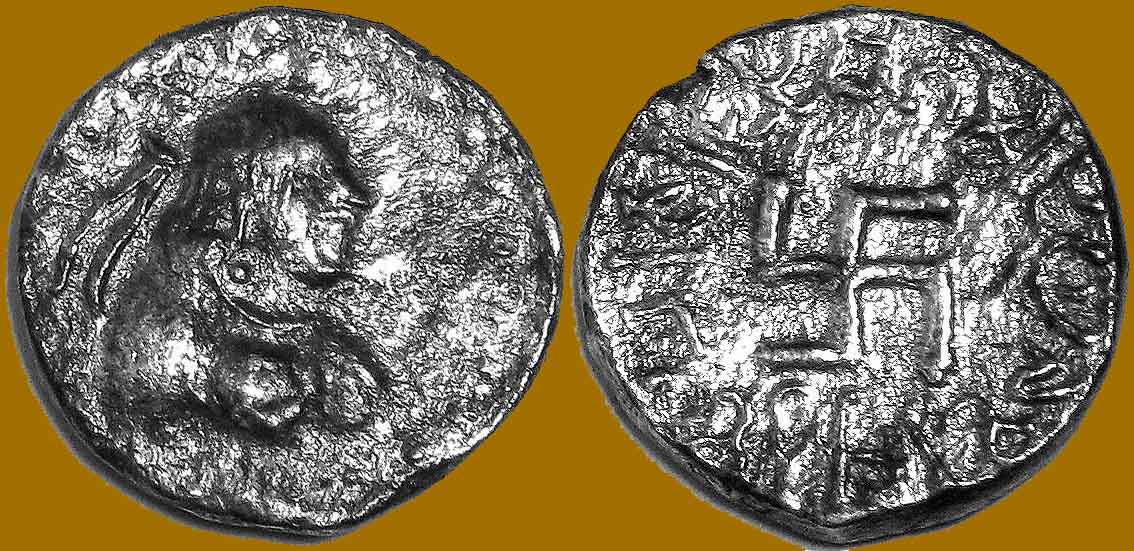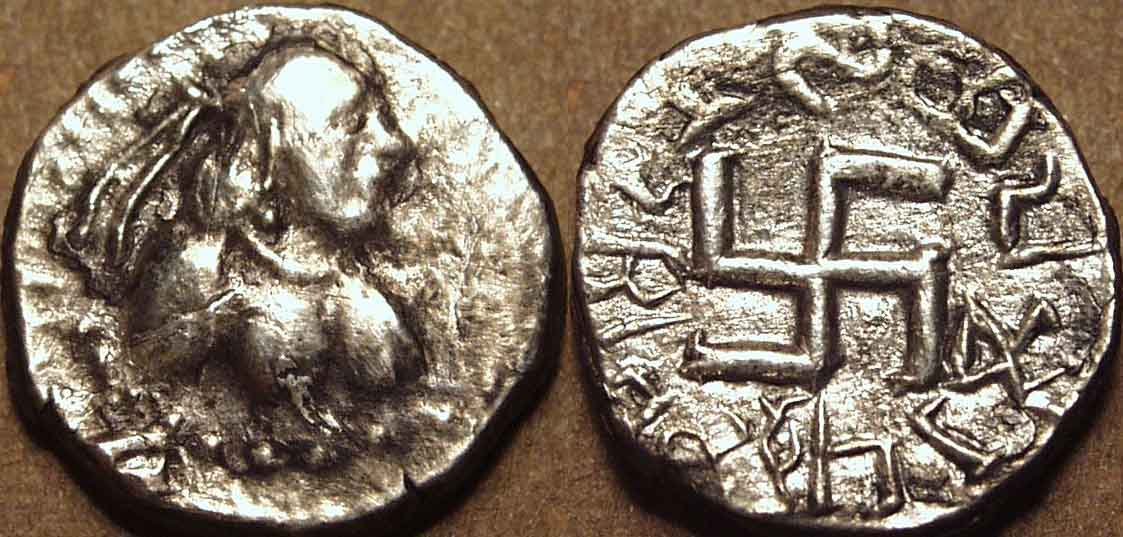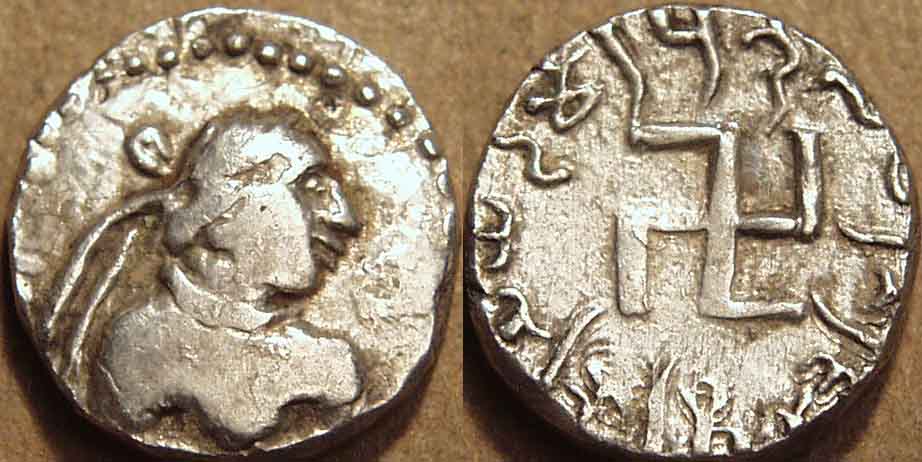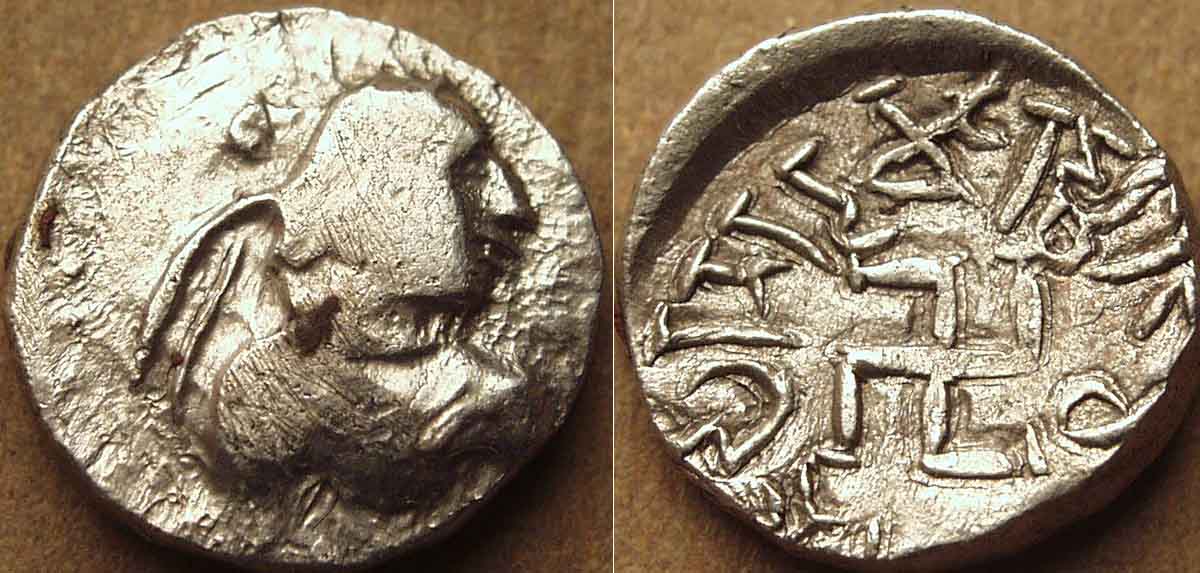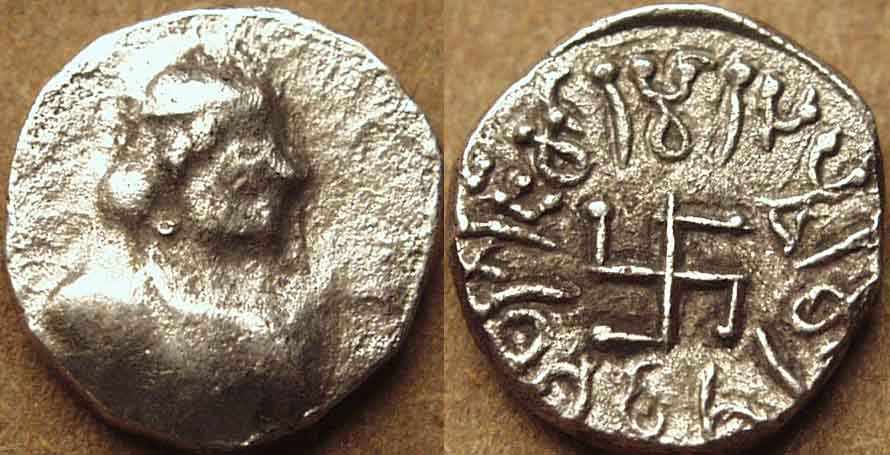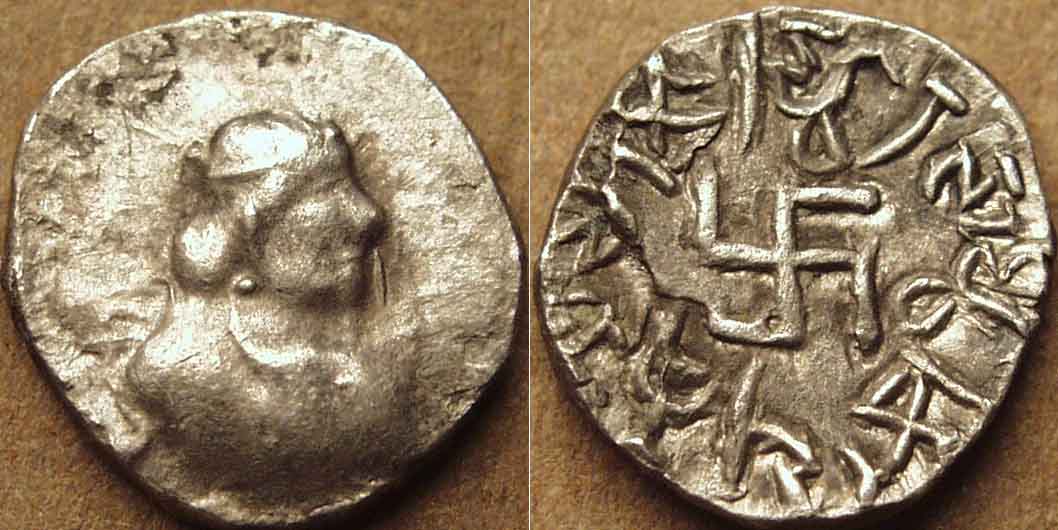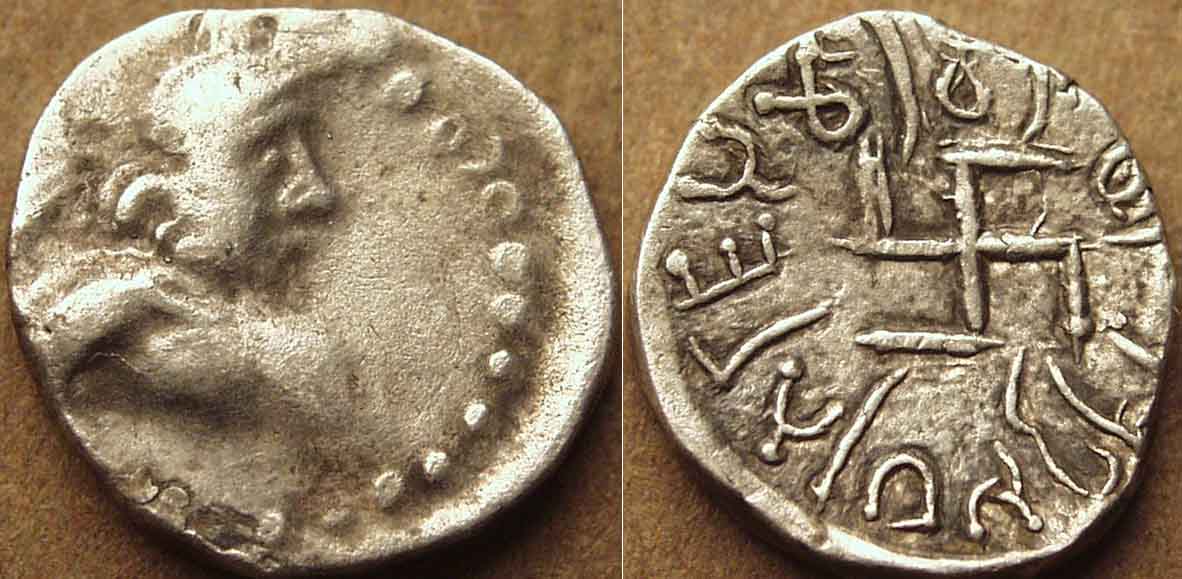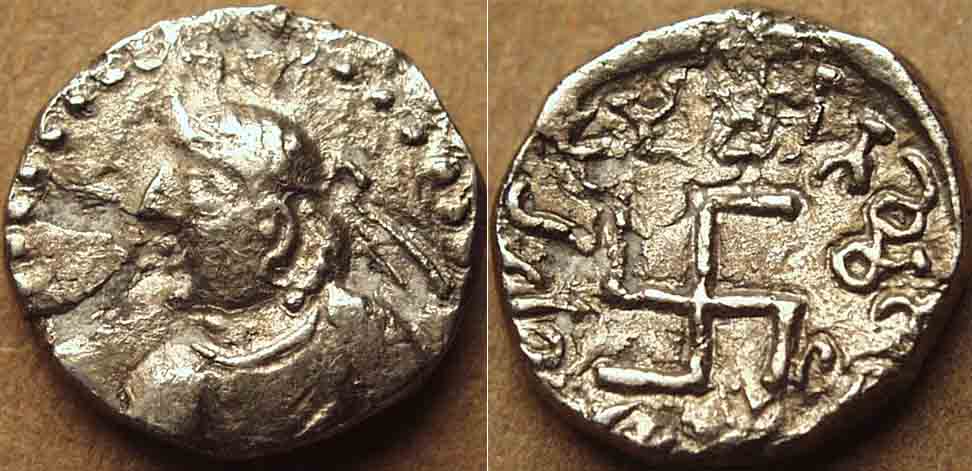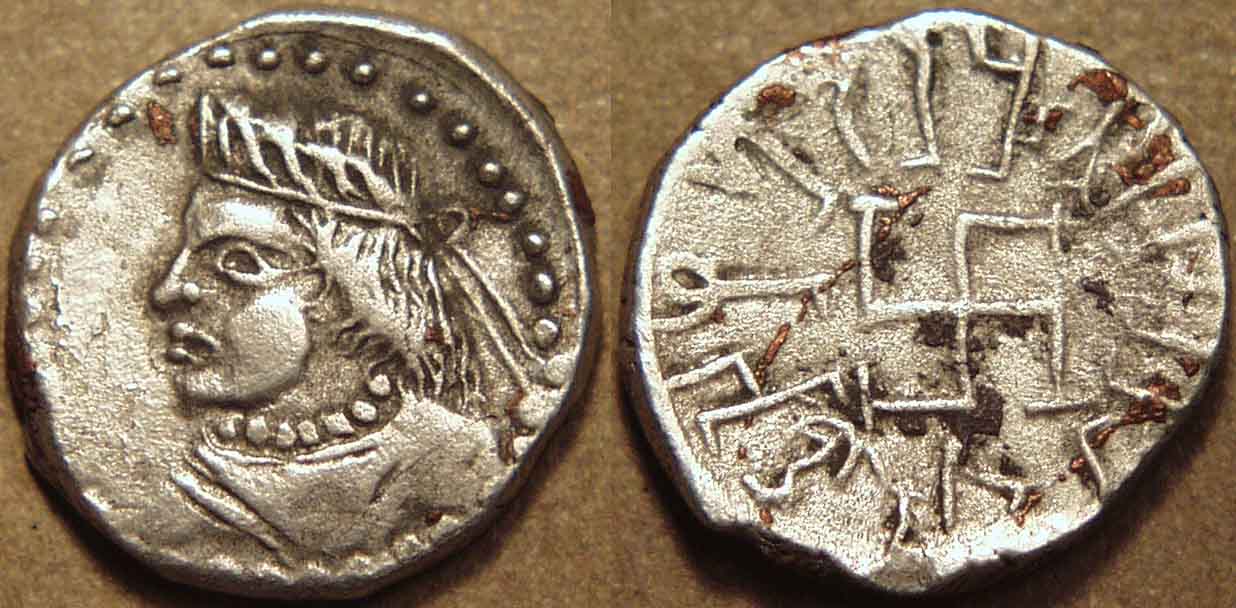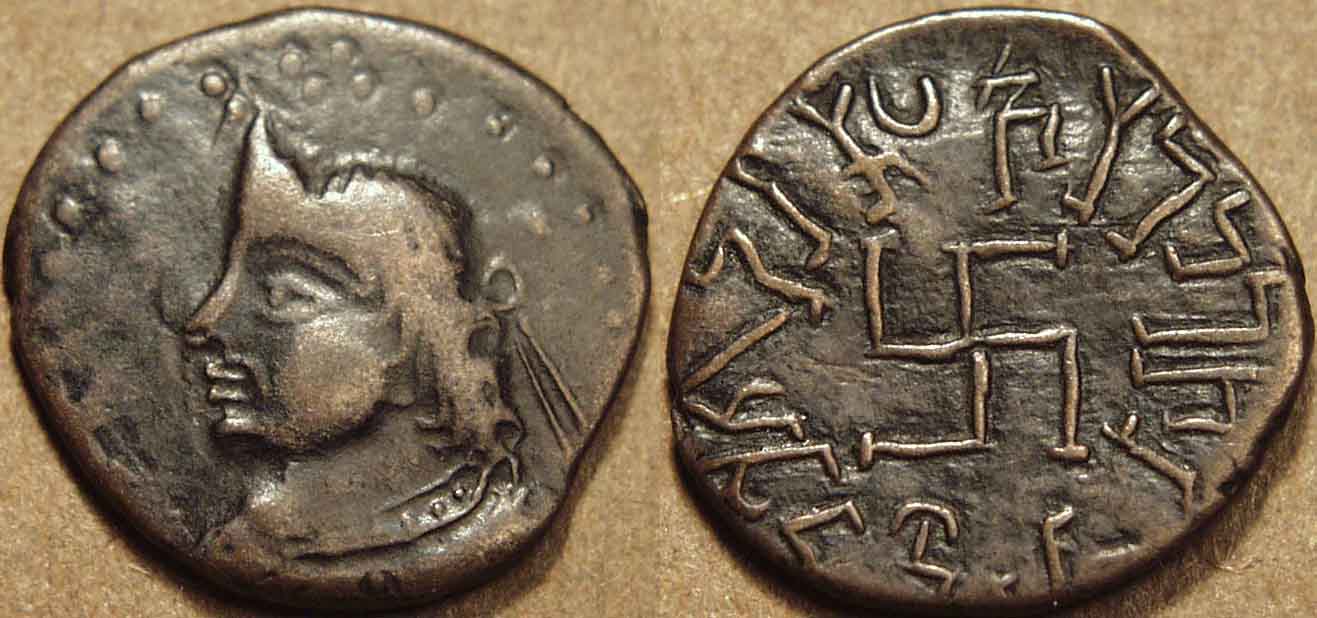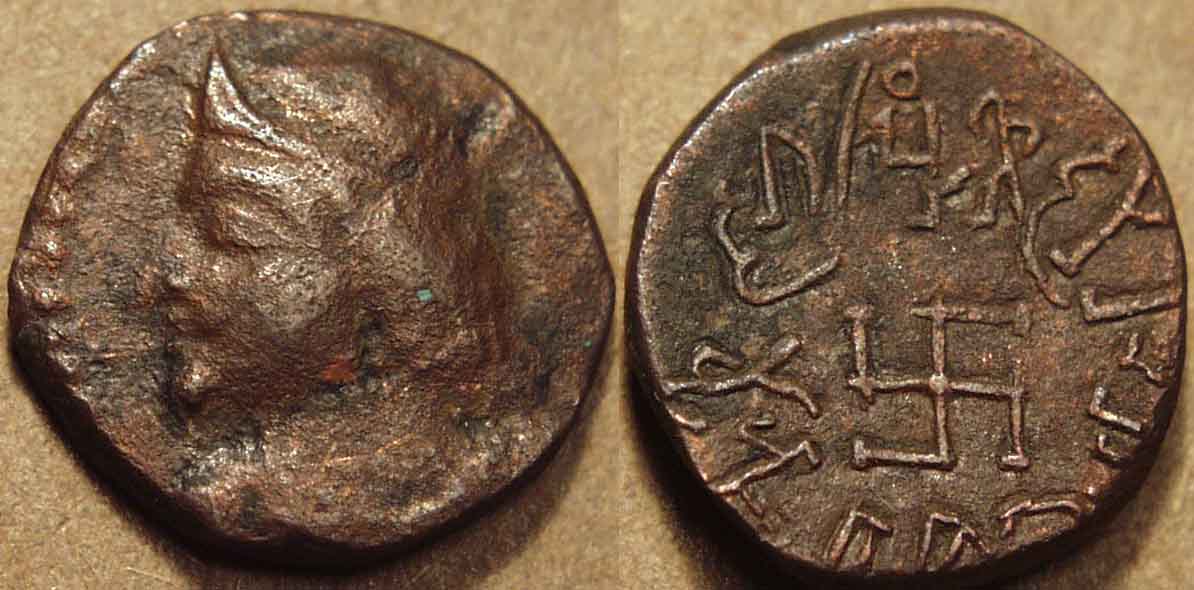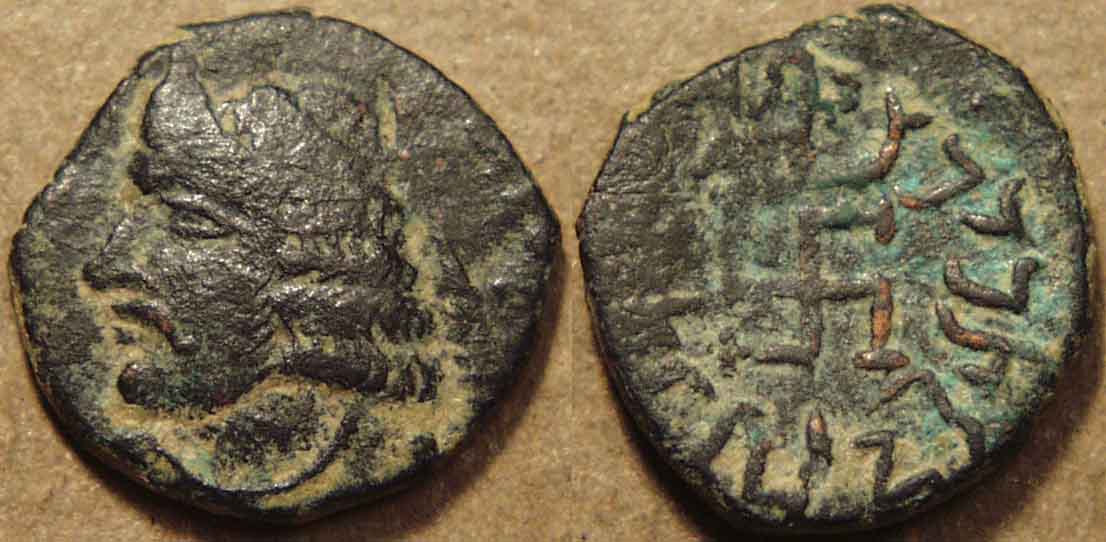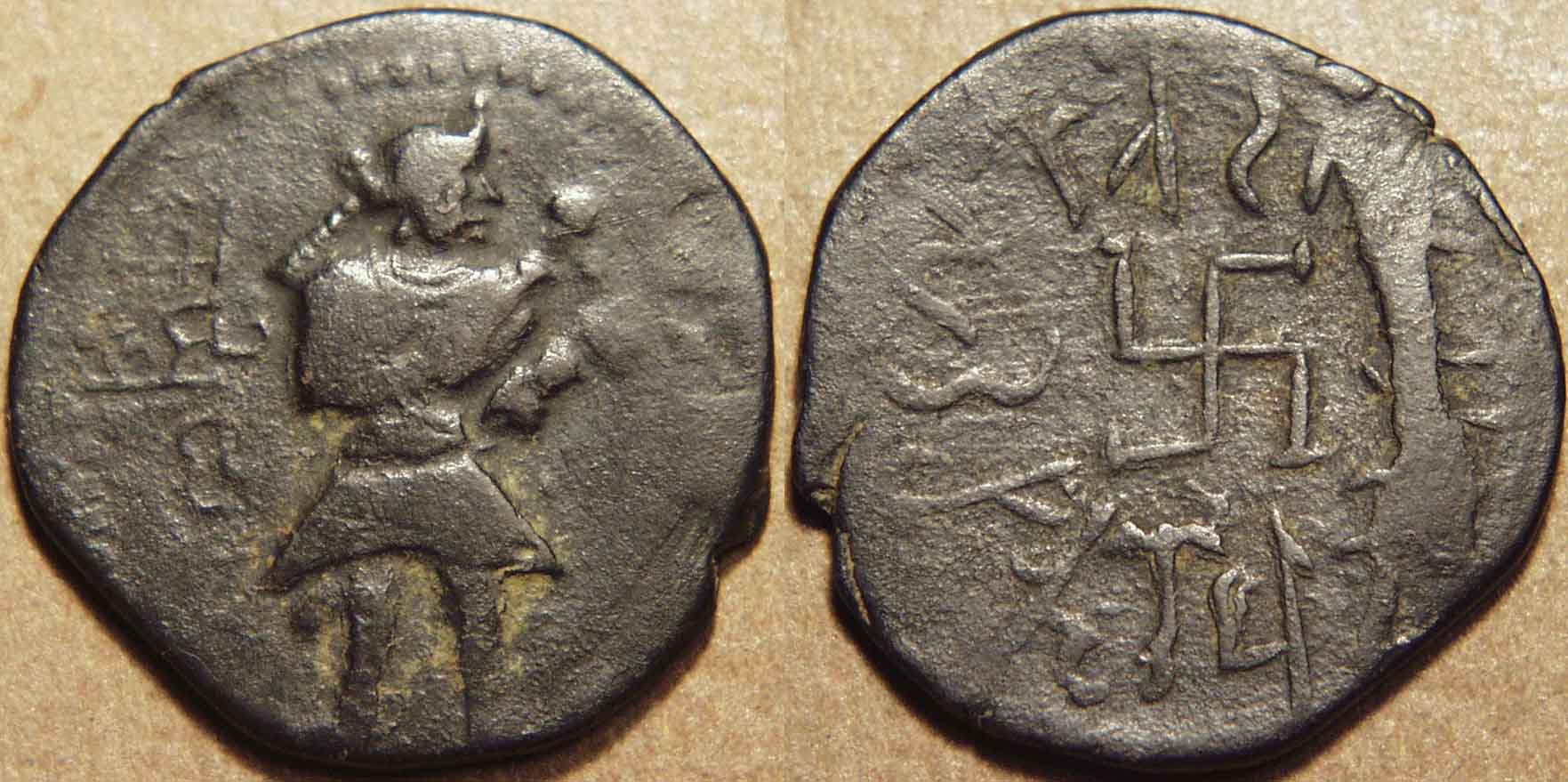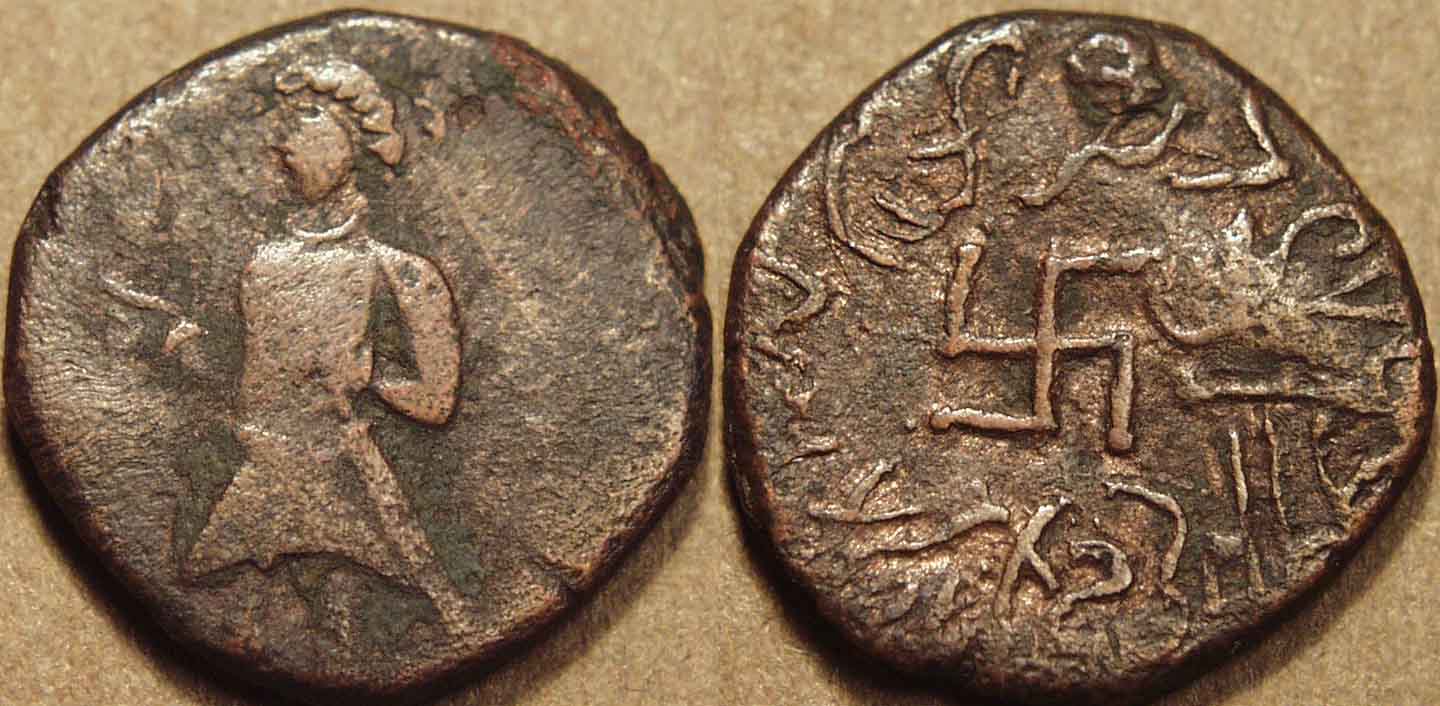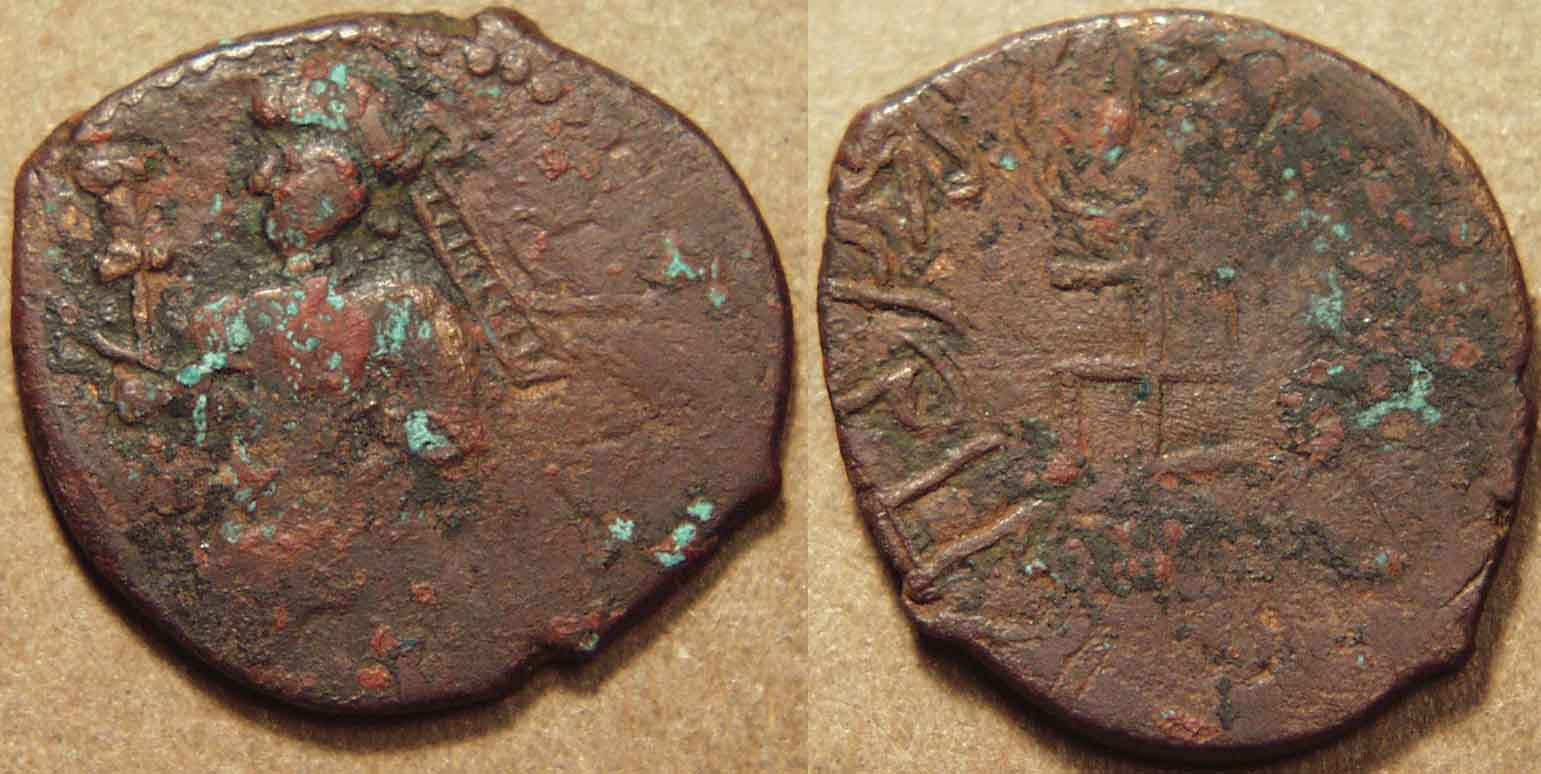This is an addendum to
Alternating arms of Svastika orthography signify alchemical transformation and Hindu rasavāda, alchemical tradition https://tinyurl.com/y4kt2a97About 50 seals of Indus Script Corpora signify right-handed and left-handed svastika hypertexts.![Image result for svastika british museum]()
![Image result for svastika bharatkalyan97]() The svastika hieroglyph is deployed on Coins from Thrace (ancient Bulgaria/Romania), Sri Lanka and Parataraja coins.
The svastika hieroglyph is deployed on Coins from Thrace (ancient Bulgaria/Romania), Sri Lanka and Parataraja coins.![]()
11198. MACEDON, EION, 500-480 BC. Trihemiobol. Goose standing right with head reverted, lizard above. /Quadripartite incuse. VF.
I suggest that these are Indus Script hieroglyphs. vartaka 'goose' *vartakara ʻ making turns (of the quail) ʼ. [Pop. etym. for vártikā -- (vartīra -- m. Suśr., ˚tira -- m. lex.)? -- varta -- 1 , kará -- 1 ]Ku. B. baṭer ʻ quail ʼ; Or. baṭara, batara ʻ the grey quail ʼ; Mth. H. baṭer f. ʻ quail ʼ; -- → P. baṭer, ˚rā m., ˚rī f., L. baṭērā m., S. baṭero m.; K. bāṭuru m. ʻ a kind of quail ʼ, baṭēra m. ʻ quail ʼ. (CDIAL 11559) rebus: vartaka 'a sort of brass or steel' vartaka वर्तकम् A sort of brass or bell-metal. (Apte) sattva 'svastika hieroglyph' rebus: sattva, jasta 'zinc, pewter'.
Association of svastika (sattva 'hieroglyph' rebus: satta 'zinc, pewter') with anchor (Meluhha: negili), and fish (aya 'fish' rebus: ayas 'alloy metal') are significant and point to seafaring and metalwork.
nāgali, nāgelu or నాగేలు nāgali. [Tel.] n. A plough. నాగటికర్రు a plough-share. నాగటిచిప్ప or నాగటిదుంప the wooden part of the plough on which the share is fixed. నాగటిజోదు an epithet of Balarama. (Telugu)
lāṅgūlá (lāṅgula -- Pañcat., laṅgula -- lex.) n. ʻ tail ʼ ŚāṅkhŚr., adj. ʻ having a tail ʼ MBh., ʻ penis ʼ lex. 2. *lāṅguṭa -- . 3. *lāṅguṭṭa -- . 4. *lāṅguṭṭha -- . 5. *lēṅgula -- . 6. *lēṅguṭṭa -- . [Cf. lañja -- 2 . -- Variety of form attests non -- Aryan origin: PMWS 112 (with lakuṭa -- ) ← Mu., J. Przyluski BSL 73, 119 ← Austro<-> as.]
1. Pa. laṅgula -- , na˚ n. ʻ tail ʼ, Pk. laṁgūla -- , ˚gōla -- , ṇaṁgūla -- , ˚gōla -- n.; Paš. laṅgūn n. ʻ penis ʼ; K. laṅgūr m. ʻ the langur monkey Semnopithecus schistaceus ʼ; P. lãgur, lag˚ m. ʻ monkey ʼ; Ku. lãgūr ʻ long -- tailed monkey ʼ; N. laṅgur ʻ monkey ʼ; B. lāṅgul ʻ tail ʼ, Or. laṅgūḷa, lāṅguḷa; H. lagūl, ˚ūr m. ʻ tail ʼ, laṅgūr m. ʻ longtailed black -- faced monkey ʼ; Marw. lagul ʻ penis ʼ; G. lãgur, ˚ul (l?) m. ʻ tail, monkey ʼ, lãguriyũ n. ʻ tail ʼ; Ko. māṅguli ʻ penis ʼ (m -- from māṅgo ʻ id. ʼ < mātaṅga -- ?); Si. nagula ʻ tail ʼ, Md. nagū.2. Or. lāṅguṛa, nā˚ ʻ tail ʼ, nāuṛa ʻ sting of bee or scorpion ʼ (< *nāṅuṛa?); Mth. lã̄gaṛ, nāgṛi ʻ tail ʼ; M. nã̄goḍā, nã̄gāḍā, nã̄gḍā, nã̄gā m. ʻ scorpion's tail ʼ.3. Sh.jij. laṅuṭi ʻ tail ʼ, Si. nan̆guṭa, nag˚, nakuṭa. -<-> X lamba -- 1 : Phal. lamḗṭi, Sh.koh. lamŭṭo m., gur. lamōṭṷ m.4. Pa. naṅguṭṭha -- n. ʻ tail ʼ.5. A. negur ʻ tail ʼ, B. leṅguṛ.6. Aw.lakh. nẽgulā ʻ the only boy amongst the girls fed on 9th day of Āśvin in honour of Devī ʼ.Addenda: lāṅgūlá -- [T. Burrow BSOAS xxxviii 65, comparing lāṅgula -- ~ Pa. nȧguṭṭha -- with similar aṅgúli -- ~ aṅgúṣṭha -- , derives < IE. *loṅgulo -- (√leṅg ʻ bend, swing ʼ IEW 676)]1. Md. nagū (nagulek) ʻ tail ʼ (negili ʻ anchor ʼ?).(CDIAL 11009).
I suggest that the gorgon or gorgoneion shown on ancient coins together with fish, anchor signify mũh 'face' rebus: mũh 'ingot'.
![]() FS 126 Anchor (?) This is a Field Symbol on Indus Script Corpora.
FS 126 Anchor (?) This is a Field Symbol on Indus Script Corpora.![]()
2nd century B.C. Æ coin (26 mm, 5.38 g). 'Lanky' bull advancing left, with indradhavaja to left and 4-nandipada symbol above / Tree-in-railing in centre; chakra to left with nandipada above; swastika to right with Ujjain symbol above; and 6-arched hill at the bottom. Pieper 976-977; MACW 4588. https://www.coinarchives.com/a/results.php![]() Gorgon head, silver didrachm issued by Athens, c. 520 BCE.
Gorgon head, silver didrachm issued by Athens, c. 520 BCE.
![]() Thrace, Black Sea Area, Apollonia Pontika AR Drachm. ca 450 BC. Facing gorgoneion with protruding tongue / Anchor, A to left, crayfish to right.
Thrace, Black Sea Area, Apollonia Pontika AR Drachm. ca 450 BC. Facing gorgoneion with protruding tongue / Anchor, A to left, crayfish to right.
![]()
![Ancient Coins - Thrace, Apollonia Pontika, late 5th-4th centuries BC. AR Hemiobol. Anchor R/ Swastika RARE]() Thrace, Apollonia Pontika, late 5th-4th centuries BCE AR Hemiobol (6mm, 0.39g). Anchor; A to l., four pellets below lower crossbar. R/ Swastika within incuse. Cf. SNG BMC Black Sea 149.
Thrace, Apollonia Pontika, late 5th-4th centuries BCE AR Hemiobol (6mm, 0.39g). Anchor; A to l., four pellets below lower crossbar. R/ Swastika within incuse. Cf. SNG BMC Black Sea 149. ![]() Apollonia Pontika, Thrace. AR hemiobol. 5th-4th century BC. 0.354 gr, 6.54 mm. Anchor, A in field / Swastika with two parallel lines in each quadrant. SNG BM 149; Moushmov 3146.
Apollonia Pontika, Thrace. AR hemiobol. 5th-4th century BC. 0.354 gr, 6.54 mm. Anchor, A in field / Swastika with two parallel lines in each quadrant. SNG BM 149; Moushmov 3146.![]() Apollonia Pontika AR Drachm, Late 5th-early 4th century BC. Upright anchor; crayfish in left section / Swastika within incuse. BMC Black Sea 148; SNG Copenhagen 451; SNG Stancomb 30.
Apollonia Pontika AR Drachm, Late 5th-early 4th century BC. Upright anchor; crayfish in left section / Swastika within incuse. BMC Black Sea 148; SNG Copenhagen 451; SNG Stancomb 30.![]() Apollonia Pontika, Thrace. Circa 450 BC. AR Drachm (3.57 gm). Anchor; crayfish right / Swastika with dolphins in angles. SNG BM Black Sea -; SNG Stancomb 30.
Apollonia Pontika, Thrace. Circa 450 BC. AR Drachm (3.57 gm). Anchor; crayfish right / Swastika with dolphins in angles. SNG BM Black Sea -; SNG Stancomb 30.
![]() Thrace, Black Sea Area. Apollonia Pontika. Circa 450 BC. AR Drachm. Anchor; crayfish right / Swastika with dolphins in angles.https://tinyurl.com/y5ckdmre
Thrace, Black Sea Area. Apollonia Pontika. Circa 450 BC. AR Drachm. Anchor; crayfish right / Swastika with dolphins in angles.https://tinyurl.com/y5ckdmre
http://www.wildwinds.com/coins/greece/thrace/apollonia_pontika/i.html


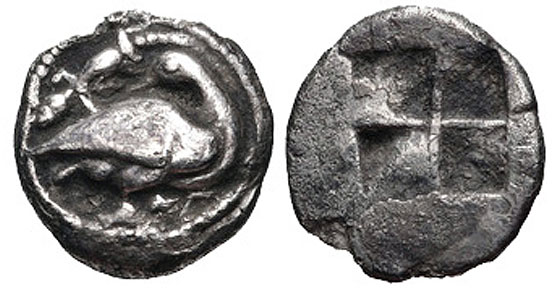
| 11198. MACEDON, EION, 500-480 BC. Trihemiobol. Goose standing right with head reverted, lizard above. /Quadripartite incuse. VF. |

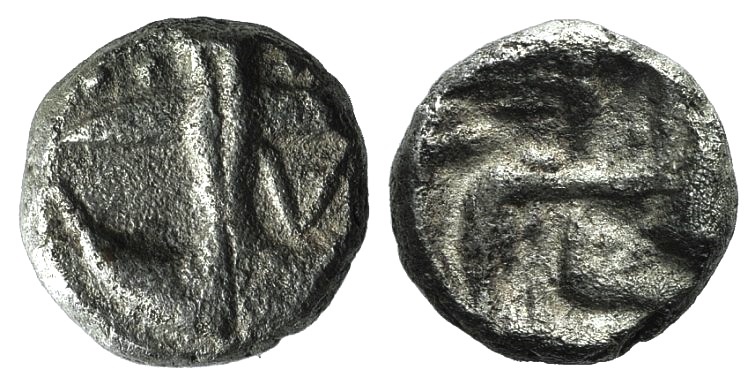



Rev: Railed swastika revolving to right between two segments of a circle placed back to back ; the whole within an oblongframe Size: 0.80 x 0.39 in. Weight: 13.6 gr. Slightly broken, 7. III- The remainder, forming the great majority of the plaques hitherto found in Ceylon, are best described by Mr. Still’s ib pg 206-212; Manufacture of these plaque is of the most careless description Evidently sheet copper was sliced into stripes of suitable width which were then chopped into pieces small enough to fit the die. “No single specimen that I have seen was well struck even on one side and in no instance is the whole of the device clearly visible. That this is not the result of wear may be clearly seen on examination of the edges, which remain so sharp that almost any specimen would cut the skin if drawn sharply across ones fingers. The corners too are exceedingly sharp in some instances and quite unworn.”


Eight-branched tree :-
(i)Obv: In line circle eight-branched tree with in enclosure of four compartments.Tor. symbol No1, off coin.
Rev: Railed swastika revolving r, symbol to l. obliterated ,symbol to r off coin.
Diameter : 0.5? in Weight : 22.8 gr Pieris XIV, 6.
16. Four-branched tree:-
.(1A)Obv. : Four-branched tree within enclosure of four compartments. on the upper corners of which apparently a dot surmounted by two small lines forming a right angle with the apex uppermost. To r., two symbols, No.1 above with group of three dots on r. side and below swastika. Symbols to l. off flan.
Rev. : Large railed swastika revolving r. between two indistinct symbols perhaps Nandipada to l .and No. 4 to r. To upper r. of last a group of three dots under swastika a (?) caitya.
Diameter: 0.94in. Weight: 37.4 gr. Thin and worn, Found in river bed 4 feet from surface immediately below the Ruhunu Maha Kataragama Temple. The remainder, unless otherwise stated, are from Vallipuram.
![ld_1a]()
.(1A)Obv. : Four-branched tree within enclosure of four compartments. on the upper corners of which apparently a dot surmounted by two small lines forming a right angle with the apex uppermost. To r., two symbols, No.1 above with group of three dots on r. side and below swastika. Symbols to l. off flan.
Rev. : Large railed swastika revolving r. between two indistinct symbols perhaps Nandipada to l .and No. 4 to r. To upper r. of last a group of three dots under swastika a (?) caitya.
Diameter: 0.94in. Weight: 37.4 gr. Thin and worn, Found in river bed 4 feet from surface immediately below the Ruhunu Maha Kataragama Temple. The remainder, unless otherwise stated, are from Vallipuram.

(1B) (a)(i) Obv.: within double-line circle within enclosure of four compartments tree with two branches at the top . The treetop and each branch ends in a group of three dots. Two branches also spring from the base of the tree at the enclosure, the l. hand with two dots at the end, the r. hand with one. To l. of enclosure symbol No.1; to r obliterated
Rev : Railed swastika revolving r.; a group of three dots to l of head To l, symbol No l, to r Nandipada with two dots above.Rectangular with circular die.
Size:0.53 x 0.57 in, weight :41.8 gr, Peries,XIV,1.from Kantarodai
Rev : Railed swastika revolving r.; a group of three dots to l of head To l, symbol No l, to r Nandipada with two dots above.Rectangular with circular die.
Size:0.53 x 0.57 in, weight :41.8 gr, Peries,XIV,1.from Kantarodai
(ii) Obv . In line circle similar tree. Symbol No 1 to l., Nandipada to r,
Rev : As last, but no dots. Horizontal line over symbol No 1 : symbol to r off coin Caitya below rail.Rectangular with circular die ; Obv. die placed diamond-wise. Broken
Size : 0.55 x 0.41 in Weight : 18.2gr Pieris XIV,2 Pl 12
![ts_ccc12]()
![ld_1bbi]()
Rev : As last, but no dots. Horizontal line over symbol No 1 : symbol to r off coin Caitya below rail.Rectangular with circular die ; Obv. die placed diamond-wise. Broken
Size : 0.55 x 0.41 in Weight : 18.2gr Pieris XIV,2 Pl 12


(iii)Obv. : In line circle similar tree as (i); but three dots at ends of lower branches. Symbol to l, obliterated ; Nandipada to r.
Rev: Railed swastika; symbol No 1 with two projections or r. side to r; Nandipadawith horizontal line above to r.Rectangular with circular die; Obv die placed diamond-wise.Rev.: worn.
Size : 0.45 x 0.37 in Weight : 17gr Pieris, XIV, 3.
Rev: Railed swastika; symbol No 1 with two projections or r. side to r; Nandipadawith horizontal line above to r.Rectangular with circular die; Obv die placed diamond-wise.Rev.: worn.
Size : 0.45 x 0.37 in Weight : 17gr Pieris, XIV, 3.
(b)(i)Obv : In double-line circle four-branched tree in enclosure of four compartments. To l, symbol No 1; symbol to r off coin.
Rev: Railed swastika above remnant of caitya; to l.Nandipada,to r remnant of symbol No 1.
Diameter : 0.68 in. Weight : 52.8 gr, From Kantarodai.
Rev: Railed swastika above remnant of caitya; to l.Nandipada,to r remnant of symbol No 1.
Diameter : 0.68 in. Weight : 52.8 gr, From Kantarodai.
(ii) Obv. : In line circle similar tree, but top and upper branches end in triple and the lower in quadruple fork; enclosure divided by three vertical lines. To l. (?) symbol No. 1, that to r obliterated.
Rev.: In similar circle railed swastika revolving r. betweenNandipada with square top on l, and or r. variety of symbol No 4 ; in it the two side lines meet, and from their junction a small vertical line springs. In lieu of the cross line in the middle is a short projection on the l and over the whole a horizontal line
Diameter : 0.70 in. Weight 42.3 gr Slightly broken PerisXIV,12. PL 13
![ts_ccc13]()
![ld_ 1baiii]()
Rev.: In similar circle railed swastika revolving r. betweenNandipada with square top on l, and or r. variety of symbol No 4 ; in it the two side lines meet, and from their junction a small vertical line springs. In lieu of the cross line in the middle is a short projection on the l and over the whole a horizontal line
Diameter : 0.70 in. Weight 42.3 gr Slightly broken PerisXIV,12. PL 13


(iii)Obv : Similar tree branches ending in triple fork ; enclosure of twelve compartments. Symbols off coin
Rev.: Railed swastika revolving r. To r. symbol with horizontal line above, symbol to l off coin
Diameter :0.62 in. Weight, 26.8 gr
Rev.: Railed swastika revolving r. To r. symbol with horizontal line above, symbol to l off coin
Diameter :0.62 in. Weight, 26.8 gr
(iv)Obv : As last, Rev.: As last ; to r symbol perhaps the same as on (ii), that to l obliterated.
Diameter 0.62 in. Weight 26.6 gr, Broken Pieris XIV, 18.
![ts_ccc12]()
![ld_1bbi]()
Diameter 0.62 in. Weight 26.6 gr, Broken Pieris XIV, 18.


(v)Obv: Tree as last, but enclosure of four compartments; indistinct symbol to l symbol to r off coin. All in line circle.
Rev : Railed swastika revolving r, Indistinct symbol on 1.,symbol No 1 on r,Rectangular.
Size 0.47×0.45in Weight:21.8gr. Pieris XIV, 4.
![pep_4]()
![ld_1bbii]()
Rev : Railed swastika revolving r, Indistinct symbol on 1.,symbol No 1 on r,Rectangular.
Size 0.47×0.45in Weight:21.8gr. Pieris XIV, 4.


(vi)Obv. : Similar tree, enclosure not visible. To r symbol No 1 with short projection on l, Symbol to r. obliterated.
Rev. : Railed swastika revolving r.
Diameter : 0.43 in Weight : 15.1 gr,
Rev. : Railed swastika revolving r.
Diameter : 0.43 in Weight : 15.1 gr,
(2) Six-branched tree:-
Obv: with in bead and line circle six branched tree, each branch ending in triple fork, in enclosure of twelve compartments; to l. (?} variant of symbol No4, to r. symbol obliterated,
Rev: Railed swastika revolving To l. obliterated symbol, or.(?)pot.
Diameter : 0.?8 in Weight : 62.2 gr. Slightly broken. Pieris, XIV, 13 PI 14.
Obv: with in bead and line circle six branched tree, each branch ending in triple fork, in enclosure of twelve compartments; to l. (?} variant of symbol No4, to r. symbol obliterated,
Rev: Railed swastika revolving To l. obliterated symbol, or.(?)pot.
Diameter : 0.?8 in Weight : 62.2 gr. Slightly broken. Pieris, XIV, 13 PI 14.
(3) Eight-branched tree :-
(i)Obv: In line circle eight-branched tree with in enclosure of four compartments.Tor. symbol No1, off coin.
Rev: Railed swastika revolving r, symbol to l. obliterated ,symbol to r off coin.
Diameter : 0.5? in Weight : 22.8 gr Pieris XIV, 6.
(i)Obv: In line circle eight-branched tree with in enclosure of four compartments.Tor. symbol No1, off coin.
Rev: Railed swastika revolving r, symbol to l. obliterated ,symbol to r off coin.
Diameter : 0.5? in Weight : 22.8 gr Pieris XIV, 6.
(ii)Obv. : Similar tree but in enclosure of six compartments; to l symbol No. 1, to r. indistinct symbol.
Rev.: In line circle railed swastika revolving 1; (?) variant of symbol No 6. with smaller triangle above on L Symbol to r. off flan.
Diameter : 0.53 in. Weight: l9.8 gr Pieris, XIV, 5
Rev.: In line circle railed swastika revolving 1; (?) variant of symbol No 6. with smaller triangle above on L Symbol to r. off flan.
Diameter : 0.53 in. Weight: l9.8 gr Pieris, XIV, 5
(iii)Obv. : As (i), but each of the four compartments contains a dot. To l. Nandipada; symbol to r is off the flan.
Rev. : Railed swastika revolving r. with line beneath. To l symbol as last, to r. indistinct symbol of which the upper part consists of two horizontal lines,
Diameter : 0.53 in Weight,16.3 gr. Pl 15.
Rev. : Railed swastika revolving r. with line beneath. To l symbol as last, to r. indistinct symbol of which the upper part consists of two horizontal lines,
Diameter : 0.53 in Weight,16.3 gr. Pl 15.

Obverse:elephant PLUS five other Indus script hypertexts Reverse: four Indus Script hypertexts including dotted circle + fish-fin pair '-- dhatu dul ayo kammaṭa, 'mineral, alloy metal, metal casting mint' hypertext. kuTi 'tree' rebus: kuThi 'smelter' danga 'mountain range' rebus: dhangar 'blacksmith'. karibha, ibha 'elephant' rebus: karba, ib 'iron' kammatamu 'portable furnace for gold' rebus: kammaTa 'mint, coiner, coinage'. karada 'currycomb' rebus: karada 'daybook, ledger' PLUS sattva 'svastika glyph' rebus: sattva 'zinc, pewter'. khambhaṛā 'fin' PLUS aya 'fish' rebus: ayas 'alloy metal' PLus kammaTa 'mint, coiner, coinage'.
Parataraja silver and copper coins show svastika and syllabic writing, respectively, in Brāhmī and Kharoṣṭhī. Coins depicting Pārata monarchs have been found in and around the district of Loralai, Balochistan, western Pakistan. Loralai was perhaps the capital city.
According to a Naqsh-i-Rustam inscription of 262 CE, "P'rtu" (between Makran and Sindh, became one of the provinces of the Sasanian Empire. The Paratas may have been submitted by the Sasanians around the time of Ardeshir I or more probably Shapur I

Indo-Parthian Satraps (Paratarajas), Yolamira, AR Drachm, 6th-7th Century AD
(No legend)
Parthian-style bust of king right, dotted border
Brahmi script (Yolamirasa Bagarevaputrasa Parataraja)
Legend surrounding large swastika
14mm x 15mm, 3.79g
P. Tandon 22b
Notes from Asif Balloo on March 25, 2009: Paratarajas were local Indo-Parthian Satraps, who ruled an area between modern Loralai inBaluchistan and Multan. Their coinage and history has not been fully understood, but hopefully with the discovery of more coins, more insight into their history will come to light.
https://www.beastcoins.com/Parthian/Parthian.htm
Parthian-style bust of king right, dotted border
Brahmi script (Yolamirasa Bagarevaputrasa Parataraja)
Legend surrounding large swastika
14mm x 15mm, 3.79g
P. Tandon 22b
Notes from Asif Balloo on March 25, 2009: Paratarajas were local Indo-Parthian Satraps, who ruled an area between modern Loralai in
https://www.beastcoins.com/Parthian/Parthian.htm
"The Paratarajas rulers were as follows:
- Yolamira, son of Bagareva (c. 125–150 CE)
- Bagamira, son of Yolamira (c. 150 CE)
- Arjuna, a second son of Yolamira (c. 150–160 CE)
- Hvaramira, a third son of Yolamira (c. 160–175 CE)
- Mirahvara, son of Hvaramira (c. 175–185 CE)
- Miratakhma, another son of Hvaramira (c. 185–200 CE)
- Kozana, son of Bagavharna (and perhaps grandson of Bagamira?) (c. 200–220 CE)
- Bhimarjuna, son of Yolatakhma (and perhaps grandson of Arjuna?) (c. 220–235 CE)
- Koziya, son of Kozana (c. 235–265 CE)
- Datarvharna, son of Datayola I (and perhaps grandson of Bhimarjuna?) (c. 265–280 CE)
- Datayola II, son of Datarvharna (c. 280–300 CE)" (Tandon, P. "Further light on the Paratarajas", Numismatic Chronicle, 2009)
لورالای
This is a copper drachm of Parataraja Koziya (230 - 270 AD) s/o Paratararaja Kozana. The bust of king is clean-shaven. According to Dr. Tandon (The Coins of the Paratarajas - A Synthesis) , this is an early issue.
Obv: Crowned bust Left with ear flap
Rev: Swastika Right, Kharosthi legend around: @12h: Koziyasa Kozanaputrasa Pāratarājasa
Diameter = 14 mm, Weight = 1.89 gm.

Drachm of Spajhama (?) (ca.0-50 AD), Parata Rajas - Indo-Parthian governors of Saurashtra, India.
| "Diademed, beardless bust left, wearing large earrings / Swastika to right; full Kharosthi legend around: Spajhanaputrasa Paratarajasa Spajhamasa. 15mm, 1.6 grams. Senior ISCH 81.1 Spajama was the son of Spajana, as recorded on the coins. Parata Rajas were the Indo-Parthian governors of Saurashtra. Very little is known about them, including the extand of their dominion, the names of their rulers or the dates of their reigns. Parata Rajas became independent in 78 AD, an event leading to the establishment of the Saka Era - their descendants ruled Saurashtra for over 300 years and Kshaharatas and Kshatrapas of Saurashtra. Parata Rajas issued silver and billon coins that later inspired the coinage of the Kshaharatas and later of the Indo-Saka Kshatrapas - Portrait facing right (usually) on obverse and a circular inscription surrounding a central device (always swastika in case of Parata Rajas). The inscriptions are usually in Karoshti, but of the same presentation as the later Kshatrapa coinage. All their coins are extremely obscure, usually very worn and/or corroded and very-very rare. Virtually unknown only a decade ago, many coins were published by Senior a few years ago, though many types still remain unpublished. The Parata Rajas coins retail for 200$-500$ at major auctions and are very difficult to find. The coins we are offering come from a small collection of Parata coinage and present a unique chance to get one of these rare coins."   Silver drachm of Nahapana (ca. 50-75 AD (?)), Kshaharatas of Saurashtra |

Copper drachm of Parataraja Bhimarjuna.
1.70g. Senior (Indo-Scythian) 286.1 (Bhimajhuna), since corrected to Bhimarjuna by H. Falk (Falk, H. "The names of the Paratarajas issuing coins with Kharosthi legends", Numismatic Chronicle, 2007: 171-178.)

Paratarajas ruler Arjuna. Circa 150-165 CE.
 Standing king Spajhayam holding a scepter, 1st century CE.
Standing king Spajhayam holding a scepter, 1st century CE. Portrait of Paratarajas ruler Kozana circa 200-220 CE. "The Pāratarajas was a dynasty of Parthian kings, and ruling family from what is now Pakistan, from the 1st century to the 3rd century. The seat of their capital was Balochistan.The Pāratas are thought to be identical with the Pārthava of Iranian literature, the Parthians of Greek literature, and the Pāradas of Indian literature...Based on ancient sources, the Paratas may have originated in northwestern Iran, northern Iraq or even eastern Turkey, roughly in the areas where Kurdslive today, around the 7th century BCE. They then migrated, so that Alexander the Great encountered them in the area of Bactria and Sogdiana.They then moved through Seistan to reach Baluchistan in the 1st century CE, where they settled, first on the coast, and then in the interior.[4] Indian sources also locate them in the same general area, beyond the Indus river. The Paratarajas must have maintained a strong interaction with their neighbors to the West (the Indo-Parthians), and their neighbors to the east (the Western Satraps), perhaps having a role of intermediary.The presence of the Paratarajas in Baluchistan suggests that the Kushans did not rule in that area...It seems that the Paratarajas fell into the orbit of the Sasanian Empire circa 262 CE, in light of a Naqsh-i-Rustam inscription of 262 CE stating that "P'rtu" (between Makran and Hindustan, that is, eastern Baluchistan) became one of the provinces of the Sasanian Empire. The Paratas may have been submitted by the Sasanians around the time of Ardeshir I or more probably Shapur ...From a linguistic standpoint, the Baluchi language belongs to the Iranian group of Indo-European languages, and is most closely related to Kurdish, whose locutors live today in the area from which the Paratas seem to have originally immigrated. This raises the possibility that today's Baluchis are somehow descendants of the Paratas. The Baluchi language "is classified as a member of the Iranian group of the Indo-European language family, which includes Farsi (Persian), Pushtu, Baluchi, and Kurdish. Baluchi is closely related to only one of the members of the Iranian group, Kurdish...Classical and historical sources
Portrait of Paratarajas ruler Kozana circa 200-220 CE. "The Pāratarajas was a dynasty of Parthian kings, and ruling family from what is now Pakistan, from the 1st century to the 3rd century. The seat of their capital was Balochistan.The Pāratas are thought to be identical with the Pārthava of Iranian literature, the Parthians of Greek literature, and the Pāradas of Indian literature...Based on ancient sources, the Paratas may have originated in northwestern Iran, northern Iraq or even eastern Turkey, roughly in the areas where Kurdslive today, around the 7th century BCE. They then migrated, so that Alexander the Great encountered them in the area of Bactria and Sogdiana.They then moved through Seistan to reach Baluchistan in the 1st century CE, where they settled, first on the coast, and then in the interior.[4] Indian sources also locate them in the same general area, beyond the Indus river. The Paratarajas must have maintained a strong interaction with their neighbors to the West (the Indo-Parthians), and their neighbors to the east (the Western Satraps), perhaps having a role of intermediary.The presence of the Paratarajas in Baluchistan suggests that the Kushans did not rule in that area...It seems that the Paratarajas fell into the orbit of the Sasanian Empire circa 262 CE, in light of a Naqsh-i-Rustam inscription of 262 CE stating that "P'rtu" (between Makran and Hindustan, that is, eastern Baluchistan) became one of the provinces of the Sasanian Empire. The Paratas may have been submitted by the Sasanians around the time of Ardeshir I or more probably Shapur ...From a linguistic standpoint, the Baluchi language belongs to the Iranian group of Indo-European languages, and is most closely related to Kurdish, whose locutors live today in the area from which the Paratas seem to have originally immigrated. This raises the possibility that today's Baluchis are somehow descendants of the Paratas. The Baluchi language "is classified as a member of the Iranian group of the Indo-European language family, which includes Farsi (Persian), Pushtu, Baluchi, and Kurdish. Baluchi is closely related to only one of the members of the Iranian group, Kurdish...Classical and historical sourcesIn about 440 BCE, the Greek historian Herodotus described the Paraitakenoi as a tribe ruled by Deiokes, a Median monarch who ruled on northwestern Persia. (History I.101)
Strabo in his Geographica places the "Paraitakai" in northern Iraq and western Persia (Geography XI, XV and XVI).[6] Arriandescribed how Alexander the Great encountered the Pareitakai in Bactria and Sogdiana, and had Craterus conquer them (Anabasis Alexandrou IV).
According to Isidore of Charax, the geographical area beyond Sakastene is called "Paraitakene", corresponding to modern Baluchistan and Seistan, possibly their new territory from that time (25-1 BCE).
The Periplus of the Erythraean Sea (1st century CE) describes the territory of the Paradon beyond the Ommanitic region, on the coast of Balochistan ": see Selig S. Harrison, In Afghanistan’s Shadow: Baloch Nationalism and Soviet Temptations (Washington: Carnegie Endowment for International Peace, 1981)" (Tandon, P. "New light on the Paratarajas", Numismatic Chronicle, 2006, p.11, p.30 ff.)
Coin Galleries: Pāratarājas or Pārata Rājas
  |
|
| Catalogue | |
| Coin 1: Yolamira, silver drachm, early type c. 125-150 CE Weight:3.72 gm., Diam:16 mm. Diademed bust right, dotted border / Swastika right, Brahmi legend around: (at 8h) Yolamirasa Bagarevaputasa Pāratarāja (ja retrograde) (Of Yolamira, son of Bagareva, Pārata King) | |
 | The names Yolamira and Bagareva betray the Iranian origin of this dynasty. The suffix Mira refers to the Iranian deity Mithra. Yolamirameans "Warrior Mithra." Bagareva means "rich God." (My thanks to Nicholas Sims-Williams for help in understanding the names of the kings.) |
| Coin 2: Yolamira, silver drachm, late type c. 125-150CE Weight:3.91 gm., Diam:15-16 mm. Diademed bust right, dotted border / Swastika right, retrograde Brahmi legend around: (at 7h) Yolamirasa Bagarevaputasa Pāratarājasa (Of Yolamira, son of Bagareva, Pārata King) | |
 | We know this coin is from late in Yolamira's reign, because it shares a die with coins of his son Bagamira and Arjuna ... see the next two coins. |
| Coin 3: Bagamira, silver drachm, late type c. 150 CE Weight:3.66 gm., Diam:15 mm. Diademed bust right, dotted border / Swastika right, Brahmi legend around: (at 12h) Bagamirasa Yolamiraputrasa Pāratarājasa (Of Bagamira, son of Yolamira, Pārata King) | |
 | Bagamira was probably Yolamira's oldest son, as he used his father's obverse die, which was then re-used by his younger brother Arjuna ... see the next coin. So Bagamira must have had a very short reign. This coin is so far the only one known of Bagamira ... photo courtesy Anne van't Haaff. |
| Coin 4: Arjuna, silver drachm, early type c. 150-165 CE Weight:4.46 gm., Diam:16 mm. Diademed bust right, dotted border / Swastika right, Brahmi legend around: (at 9h) Arjunasa Yolamiraputasa Pāra (sic! tarajasa missing) (Of Arjuna, son of Yolamira, Pārata King | |
 | Thia coin shares an obverse die with coins 2 (Yolamira) and 3 (Bagamira). Since Arjuna issued coins with other dies, this must have been his early type and proves he followed Bagamira. |
| Coin 5: Arjuna, silver drachm, late type c. 150-165 CE Weight:3.55 gm., Diam:17 mm. Diademed bust right, dotted border / Swastika right, Brahmi legend around: (at 9h) Arjunasa Yolamiraputasa Pārata jasa (sic! ra missing) (Of Arjuna, son of Yolamira, Pārata King | |
| Coin 6: Hvaramira, silver drachm, early type c. 165-175 CE Weight:3.39 gm., Diam:14 mm. Diademed bust right, dotted border / Swastika right, Brahmi legend around: (at 9h) Hvaramirasa Yolamirasaputasa Pāratarāja (no sa) (Of Hvaramira, son of Yolamira, Pārata King)) | |
 | Since this coin shares a die with the previous coin of Arjuna, who also issued coins that shared a die with Yolamira, we conclude that Hvaramira was Arjuna's younger brother, or at least that he ruled after him. No coins are known of any of Arjuna's sons. |
| Coin 7: Hvaramira, silver drachm, late type c. 165-175 CE Weight:3.64 gm., Diam:15-16 mm. Diademed bust right, dotted border / Swastika left, Brahmi legend around: (at 6h) Hvaramirasa Yodamirasaputasa Pāratarājasa (Of Hvaramira, son of Yolamira, Pārata King)) | |
 | Since this coin shares a die with the next coin of Hvaramira's son, we can infer that this was produced later in Hvaramira's reign. Note the left-turning swastika and the unusual spelling of Yolamira's name ... here spelled Yodamira. The word Yola means "war" in middle Persian, while "Yoda" begins to sound like "Yuddha" ... "war" in Sanskrit. |
| Coin 8: Mirahvara, silver drachm, early type c. 175-185 CE Weight:3.57 gm., Diam:15 mm. Diademed bust right, dotted border / Swastika left, Brahmi legend around: (at 12h) Mirahvarasa (H)va(ramiraputrasa) Pāratarāja (no sa) (Of Mirahvara, son of Hvaramira, Pārata King) | |
 | In a now familiar pattern, the early coins of Mirahvara use the late dies of his father. Note the unusual letter forms on this coin. |
| Coin 9: Mirahvara, silver hemidrachm c. 175-185 CE Weight:1.65 gm., Diam:11-12 mm. Diademed bust right, dotted border / Swastika right, Brahmi legend around: (at 11h) Mirahvarasa Hvaramiraputrasa Pāratarāja (no sa) (Of Mirahvara, son of Hvaramira, Pārata King) | |
 | Mirahvara revived the issuance of hemidrachms like this one (no hemidrachm of Hvaramira is known), using an obverse die that had been used by Arjuna and even Yolamira! This coin features "older" letter-forms. |
| Coin 10: Mirahvara, silver hemidrachm c. 175-185 CE Weight:1.80 gm., Diam:13-14 mm. Diademed bust right, dotted border / Swastika right, Brahmi legend around: (at 11h) Mirahvarasa Hvaramiraputrasa Pāra (legend truncated) (Of Mirahvara, son of Hvaramira, Pārata King) | |
 | A hemidrachm with the more unusual letter forms. |
| Coin 11: Mirahvara, silver drachm, late type c. 175-185 CE Weight:3.08 gm., Diam:15-16 mm. Diademed bust right, dotted border / Swastika right, Brahmi legend around: (at 10h) Mirahvarasa Hvaramiraputrasa Pāratarājasa (Of Mirahvara, son of Hvaramira, Pārata King) | |
| Coin 12: Miratakhma, silver drachm, early type c. 185-200 CE Weight:3.39 gm., Diam:14 mm. Diademed bust right, dotted border / Swastika right, Brahmi legend around: (at 12h) Miratakhmasa Hvaramiraputrasa Pāratarājasa (Of Miratakhma, son of Hvaramira, Pārata King) | |
 | Although this coin's obverse die was badly cracked, it is clearly identifiable as the same die that was used to produce coin 11 of Mirahvara ... there are coins of Mirahvara that show the same deep die crack. Miratakhma appears to have been the younger brother of Mirahvara, since he shares a die only with his brother and not with his father. |
| Coin 13: Miratakhma, silver drachm c. 185-200 CE Weight:3.30 gm., Diam:15 mm. Diademed bust right, dotted border / Swastika right, Brahmi legend around: (at 9h) (Mi)ratakhmasa Hvaramirapu(trasa Pāratarāja) (Of Miratakhma, son of Hvaramira, Pārata King) | |
 | The letter forms on this coin are most unusual, particularly the compound letter khma. It also has a quite unusual portrait style. |
| Coin 14: Miratakhma, silver drachm, late type c. 185-200 CE Weight:3.55 gm., Diam:15 mm. Diademed, crowned bust left, dotted border / Swastika right, Brahmi legend around: (at 12h) Miratakhmasa (Hvaramiraputrasa) Pāratarāja (Of Miratakhma, son of Hvaramira, Pārata King) | |
 | This coin has a couple of innovations that mark it as coming from late in Miratakhma's reign: it is the first Pāratarāja coin to have the king's bust facing left, and it is also the first coin to show the king wearing a crown ... a peaked tiara. |
| Coin 15: Kozana, silver drachm (reduced weight standard) c. 200-225 CE Weight: 2.23 gm., Diam:15 mm. Diademed, crowned bust left, dotted border / Swastika right, Kharoshthi legend around: (at 11h, counterclockwise) Kozanasa Bagavharnaputrasa Pāratarājasa (Of Kozana son of Bagavharna, Pārata King) | |
 | Kozana was the first Pāratarāja king to issue coins with the legends in Kharoshthi, like on this coin. Most authors had presumed that the Kharoshthi legend coins must have come before the Brahmi legend coins, as it was Brahmi that replaced Kharoshthi everywhere else in India. But it can be shown that Kozana's coins came after the Brahmi legend coins. His are the only Kharoshthi legend coins in silver and he follows the style of Miratakhma's late coins, with the bust left and the tiara crown (seen even better on the next coin). For more, see my 2009 paper. |
| Coin 16: Kozana, silver hemidrachm (reduced weight standard) c. 200-225 CE Weight: 1.04 gm., Diam:12-13 mm. Diademed, crowned bust left, dotted border / Swastika right, Kharoshthi legend around: (at 10h, counterclockwise) Kozanasa Bagavharnaputrasa Pāratarājasa (Of Kozana son of Bagavharna, Pārata King) | |
 | This coin shows the peaked tiara, initiated by Miratakhma, very clearly. No one knows for sure who was Kozana's father Bagavharna (pronounced Bagafarna) was, but I have suggested in my 2009 paper that he was Bagamira's son. |
| Coin 17: Bhimarjuna, billon drachm (reduced weight standard) c. 225-235 CE Weight: 2.09 gm., Diam:15-16 mm. Diademed, crowned bust left, dotted border / Swastika right, Kharoshthi legend around: (at 12h, counterclockwise) Bhimarjunasa Yolatakhmaputrasa Pāratarāja (no sa) (Of Bhimarjuna son of Yolatakhma, Pārata King) | |
 | With Bhimarjuna, the debasement of the Pārata currency starts. Some early coins show more silver than this one; later coins seem to be almost pure copper. The fact that Bhimarjuna's coinage shows the gradual debasement proves that he followed Kozana. Although we do not know who was Bhimarjuna's father, Yolatakhma, I have argued that he must have been Arjuna's son. |
| Coin 18: Koziya, copper drachm (reduced weight standard) c. 235-265 CE Weight: 2.21 gm., Diam:14-15 mm. Diademed, crowned bust left, dotted border / Swastika right, Kharoshthi legend around: (at 1h, counterclockwise) Koziyasa Kozanaputrasa Pāratarājasa (Of Koziya son of Kozana, Pārata King) | |
 | Although Koziya was Kozana's son, it seems fairly clear that he did not follow his father to the throne but had to wait until the end of his "uncle" Bhimarjuna's reign. None of Koziya's coins show any trace of silver, plus his portrait is more different from Kozana's than Bhimarjuna's was. Finally, Koziya introduced a standing king type that was then copied by later rulers. |
| Coin 19: Koziya, copper drachm (reduced weight standard) c. 235-265 CE Weight: 1.54 gm., Diam:12-14 mm. Diademed, crowned bust left, dotted border / Swastika right, Kharoshthi legend around: (at 9h, counterclockwise) Koziyasa Kozanaputrasa Pāratarāja (no sa) (Of Koziya son of Kozana, Pārata King) | |
 | Koziya issued several differnt types of copper drachms, some of very fine style, such as this one. Here, Koziya's portrait features a mustache for the first time. So Koziya must have risen to the throne as a teenager and probably had quite a long reign, given the wide variety of types he issued. |
| Coin 20: Koziya, copper drachm (reduced weight standard) c. 235-265 CE Weight: 1.28 gm., Diam:12-13 mm. Diademed bust right, wearing elaborate head-dress, dotted border / Swastika right, Kharoshthi legend around: (at 12h, counterclockwise) Koziyasa Kozanaputrasa Pāratarāja (no sa) (Of Koziya son of Kozana, Pārata King) | |
 | Here Koziya issued a copper drachm with the bust facing right and wearing a new type of head-dress. |
| Coin 21: Koziya, copper di-drachm c. 235-265 CE Weight: 3.87 gm., Diam: 20-21 mm. King standing facing, head turned to right, Brāhmi legend at left: Koziya Swastika turning right, Kharoshthi legend around (at 12 o'clock): Koziyasa Kozanaputrasa Paratarajasa (Of Koziya son of Kozana, Pārata King) | |
 | This seemingly insignificant copper coin has unlocked whole chapters of ancient Indian history! Because it has both a Brāhmi and a Kharoshthi legend, it served as a sort of "Rosetta Stone" to unlock the name of this king: Koziya (previously read as Spajheya) and thereby helped to reorganize our understanding of the coinage of the Pāratarājas. For more, see my 2009 paper. The coin is also helping re-write the history of the Western Kshatrapas; for more on this, see the paper The Western Kshatrapa Dāmazāda, also forthcoming in the Numismatic Chronicle, 2009. |
| Coin 22: Datarvharna, copper di-drachm (reduced weight standard) c. 265-280 CE Weight: 3.40 gm., Diam:17-18 mm. King standing facing, head turned to left/ Swastika right, Kharoshthi legend around: (at 2h, counterclockwise) Datarvharnasa Datayolaputrasa Pāratarāja (no sa) (Of Datarvharna, son of Datayola, Pārata King) | |
 | Datarvharna (pronounced Datarfarna) may have been Bhimarjuna's grandson. He issued no drachms as far as we know, only these didrachms with the standing king. His coins can be distinguished by the fact that the king is facing left (Koziya's standing king faces right) and the swastika turns to the right (the next coin, of Datarvharna's son Datayola has the swastika turning left). |
| Coin 23: Datayola II, copper di-drachm (reduced weight standard) c. 280-300 CE Weight: 2.83 gm., Diam:17-19 mm. King standing facing, head turned to left/ Swastika left, Kharoshthi legend around: (at 6h, counterclockwise) Datayolasa Datarvharnaputrasa Pāratarājasa (Of Datayola, son of Datarvharna, Pārata King) | |
 | Datayola must have been named for his grandfather. His coins can be distinguished by the fact that the king is facing left and the swastika also turns to the left. Datayola's coins proved crucial to the proper dating of this dynasty. His coins have been found overstruck on coins of the Kushano-Sasanian king Hormizd I, who is dated to 270-290. Thus Datayola II must have ruled somewhat contemporaneously or just after Hormizd. |
| Coin 24: Datayola II, copper tetradrachm (reduced weight standard) c. 280-300 CE Weight: 7.72 gm., Diam: 20 mm. Diademed bust of king left/ Swastika right, Kharoshthi legend around: (counterclockwise) Datayolasa Datavharnaputrasa Pāratarājasa (Of Datayola, son of Datarvharna, Pārata King) | |
 | Datayola issued this entirely new donomination - a tetradrachm. This is the heaviest Pāratarāja coin known. |

| Obverse | Bust of king facing right |
| Reverse | Swastika turning left, Brahmi legend around: arjunasa yolamiraputrasa paratarajasa (=of Arjuna, son of Yolamira, king of the Paratas) |
| Date | c. 150-165 CE |
| Weight | 1.61 gm. |
| Diameter | 12-13 mm. |
| Die axis | n.a. |
| Reference | This coin was the plate coin T14 in my paper "New Light on the Paratarajas," Numismatic Chronicle, 2006 . |
| Comments | Arjuna was apparently Yolamira's second son. For a catalogue of these coins, see the Paratarajas page on CoinIndia. |
 Parataraja dynasty of Baluchistan
Parataraja dynasty of BaluchistanDatarvharna, c. 270-280 CE
AE didrachm (20 mm, 3.25 g)
Obverse: King standing left, with hair in turban
Reverse: Swastika turning right, with Kharoshthi legend around Datarvharnasa Datayolaputrasa Paratarajo (of Datarvharna, son of Datayola, king of the Paratas)
Ref: Tandon 66; Senior S51.1

Parataraja dynasty
Koziya, c. 230-270 CE
AE didrachm (21.5 mm, 4.19 g)
Obverse: King standing right, holding sceptre; Brahmi legend Koziya to right
Reverse: Swastika turning right, with Kharoshthi legend around Koziyasa Kozanaputrasa Paratarajasa (of Koziya, son of Kozana, king of the Paratas)
Ref: Tandon 60
The Paratarajas were an Indo-Parthian dynasty that ruled in modern-day Baluchistan. Senior read Koziya's name as Spajhama, but this reading has since been corrected by Tandon.
Koziya introduced the standing king type, an innovation in Parataraja coinage.















